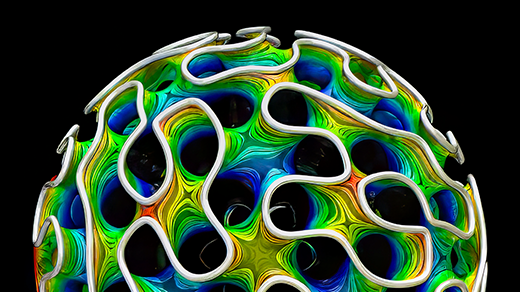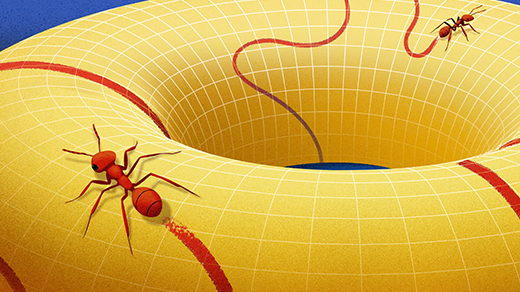A New Geometry for Einstein’s Theory of Relativity
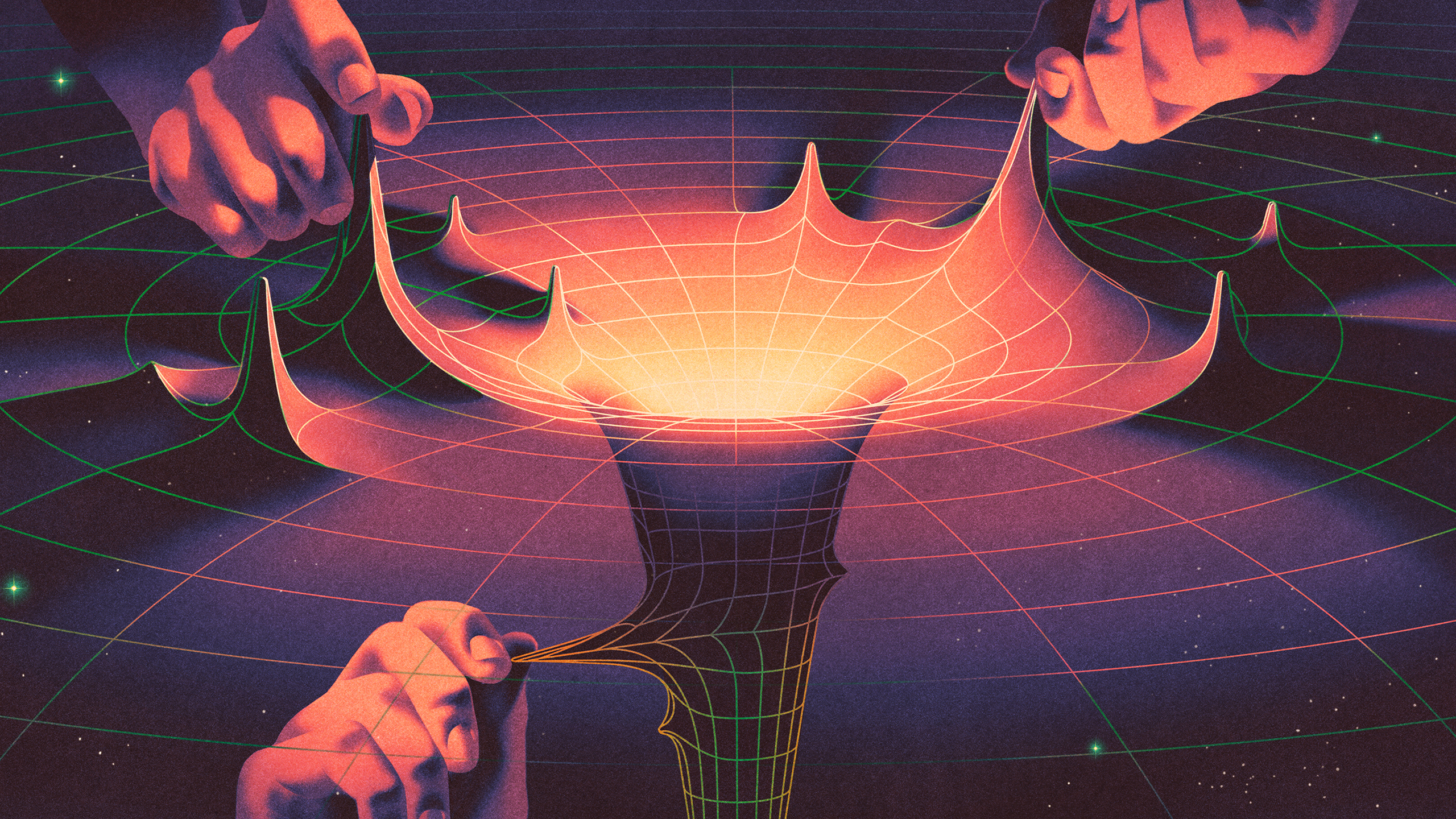
Harol Bustos for Quanta Magazine
In October 2015, a young mathematician named Clemens Sämann was flying home to Austria from a conference in Turin, Italy, when he had a chance encounter. He found himself seated beside Michael Kunzinger, another conference attendee. Kunzinger was a math professor at the University of Vienna, where Sämann had just started his postdoctoral research. They soon got to talking, landing on a subject Sämann had started thinking about in graduate school — whether there was a mathematical way to get around the limitations of Albert Einstein’s general theory of relativity.
Einstein’s theory defines gravity as the curvature of space-time caused by the presence of matter and energy. Since its formulation in 1915, it has held up remarkably well. Consisting of 10 interconnected differential equations, the theory describes how objects fall, how light bends, and how planets, stars and galaxies move. It tells us that the universe is expanding, and it predicted the existence of both black holes and gravitational waves a century before they were definitively observed.
But in spite of these successes, Einstein’s theory also has shortcomings. Its equations can only describe how matter curves space-time when the geometry of that space-time is smooth — with no sharp corners or cusps, no regions where it suddenly becomes jagged. Picture space-time as a flat rubber sheet, and matter as a bowling ball placed on that sheet, causing it to bend. If space-time is smooth, then this bending will be gradual.
But physicists know that’s not always true. A black hole, for instance, warps space-time more violently, causing the sheet to bend sharply until, at the black hole’s center (a so-called singularity), the curvature “blows up,” becoming infinite. Some physicists even posit that space-time doesn’t become non-smooth only at isolated singularities, but at every point. On the smallest scales, space-time might be “discrete,” or pixelated — broken up into tiny, disconnected bits in the same way that a fluid, while appearing to be a single uniform entity, is actually made up of distinct atoms and molecules.
In these situations, general relativity hits an impasse. Whenever space-time isn’t sufficiently smooth, Einstein’s equations stop working. They can no longer tell us how matter curves space-time, or how curved space-time influences matter.
That’s because the equations rely on a technique from calculus called differentiation that measures how quickly functions change, and differentiation is no longer possible in settings that are far from smooth. And so, on their flight back to Austria, Kunzinger and Sämann wondered whether they could devise alternative methods — ones that would still work in the inhospitable environments where the usual tools of calculus broke down.
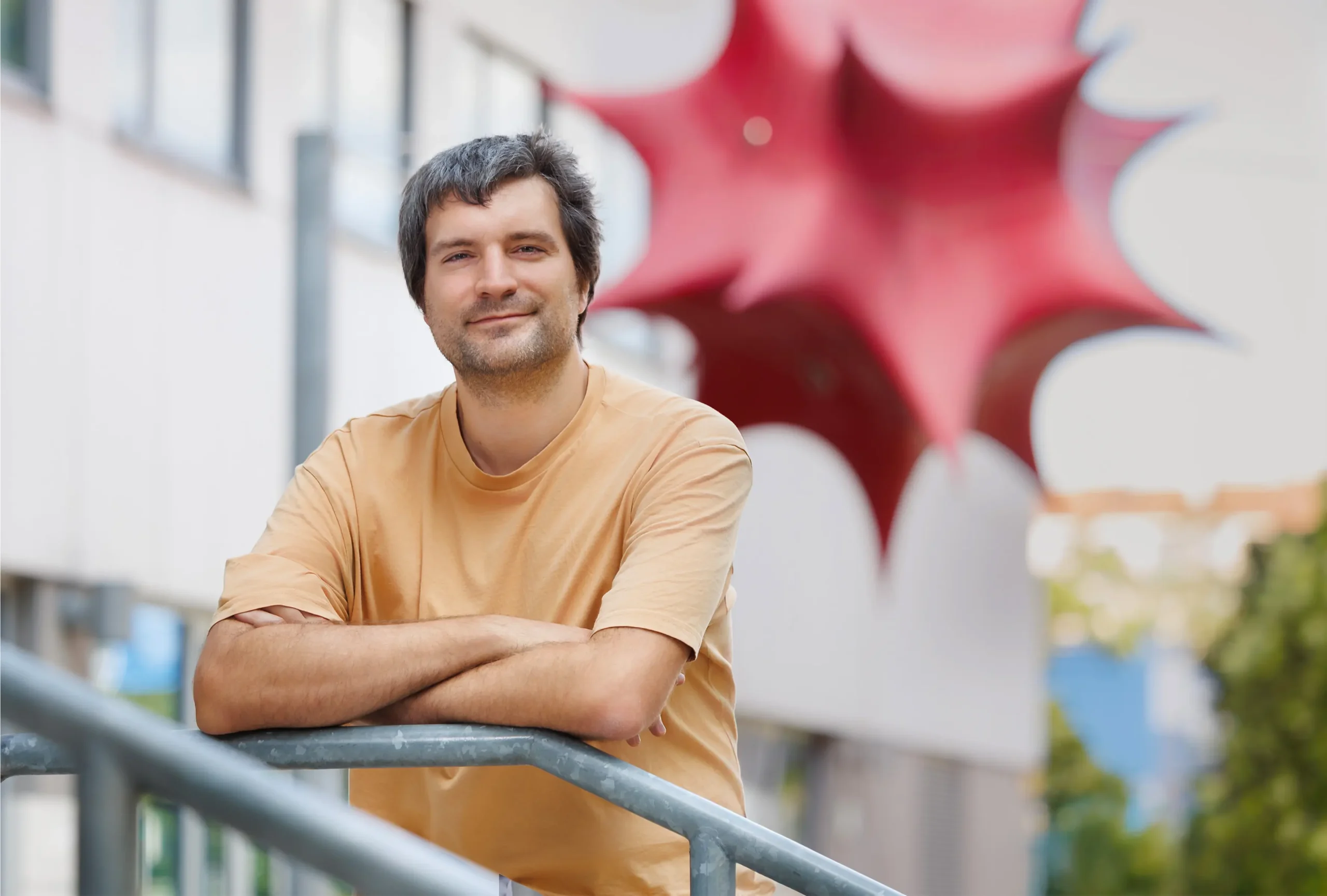
Clemens Sämann has helped prove important singularity theorems in space-times that “could have corners, edges and folds.”
Der Knopfdrücker
The pair wouldn’t start working on the problem in earnest for another year. But since then, they’ve made significant advances toward their goal. They’ve found new ways to estimate curvature and other geometric properties without relying on smoothness and differentiation. In collaboration with other researchers, they’ve used their methods to rederive (and sometimes strengthen) core theorems about the universe without depending on Einstein’s equations, putting those theorems on even firmer mathematical footing.
And they’re now part of an ambitious new program — launched last year under the direction of Roland Steinbauer, another University of Vienna mathematician — that aims to provide “a new geometry for Einstein’s theory of relativity and beyond.”
“Standard general relativity talks about geometric objects, namely space-times, but only if they behave nicely enough,” Steinbauer said. “With this new framework, we can go beyond that. We can handle very edgy objects, very badly behaved objects.”
A Path Via Triangulation
When Kunzinger and Sämann started working together in 2016, their first goal was to revisit one of the most basic concepts to appear in Einstein’s equations: curvature.
Curvature is a measure of how much space-time bends at a given point. There are many ways to describe it mathematically. Typically, computing these different types of curvature requires calculus. But Kunzinger and Sämann wanted to find a way to estimate the curvature of space-time without requiring assumptions of smoothness. In particular, they wanted to do so for the kind of curvature central to Einstein’s equations — what’s known as Ricci curvature — so that they could then use their methods to prove important statements about black holes and other phenomena.
But Ricci curvature is complicated, and Kunzinger and Sämann weren’t ready to tackle it — yet. They first turned to a more straightforward notion of curvature, called sectional curvature, which tells you how different two-dimensional slices of space-time curve at a point. If they could compute this curvature in non-smooth settings, it would still allow them to take on more restricted versions of the statements they wanted to prove.
They had an idea for where to start. When it comes to ordinary mathematical spaces — rather than the confounding space-time of general relativity — mathematicians have had an alternative way to describe sectional curvature for decades. The method allows them to put bounds on the curvature of a shape using simple triangles.
Say you have a two-dimensional surface that resembles a sphere. To estimate its curvature, first draw three points on the surface and connect them with the shortest (and therefore straightest) possible paths. This gives you a triangle. Then draw another triangle with the same side lengths on a flat plane. You already know the plane’s curvature — it’s zero — so this new triangle will give you a helpful reference.
Now compare the two triangles. You’ll find that the triangle on the spherelike surface has larger angles than the triangle on the plane, and that a line segment drawn between the midpoints of two of its sides is longer. This tells you that the curvature of your surface is greater than zero.
Mark Belan/Quanta Magazine
Similarly, you can compare the original triangle to one drawn on a highly curved surface (such as a sphere with a small radius, whose curvature can be calculated easily) in order to get an upper bound. If you continue tweaking your comparison surfaces, you can home in on a more accurate range of curvatures for your surface of interest.
By comparing triangles in this way, mathematicians get around the need to compute curvature using calculus — and their method doesn’t require the surfaces they study to be smooth.
Kunzinger and Sämann wanted to adapt this method to work for space-time, too. But carrying out triangle comparisons in the context of general relativity is more complicated, because space-time has some strange, counterintuitive features. Distances, for instance, are no longer absolute. They contract or expand depending on the observer’s speed. Moreover, computations that involve the time dimension are different from those involving just the space dimensions. (Moving in the time direction subtracts from distance calculations, rather than adding to them.)
So Kunzinger and Sämann chose to measure distance in terms of “time separation” — the time it takes to travel from one point to another, according to a clock moving along that path. (They assumed that it’s never possible to travel faster than the speed of light.)
When they then drew each side of their triangle, they chose the path that would yield the maximum time separation. That is, each edge formed the longest possible path (in terms of time), not the shortest. That’s because this path, like its counterpart on a conventional mathematical surface, is still as straight as possible. A time-based definition of distance defies our usual instincts. A more circuitous path through space-time actually takes less time than a straighter one. “Here, detours are shorter,” Kunzinger said. “That is the crux of the new setup.”
Using this notion of distance, he and Sämann drew triangles in a given model of space-time and compared them to ones drawn in a reference model where they already knew the curvature. They then showed that their method can provide good curvature estimates: They could use it to demonstrate, for instance, that in the interior of a black hole, the sectional curvature becomes infinite.
And it would work in any non-smooth setting they might choose, Sämann said, so long as they could define distance in terms of time in the same way. “Your space-time could have corners, edges and folds, and it doesn’t matter,” he said. “This approach doesn’t care about non-smoothness.”
Now they wanted to do something with their approach.
A Singular Preoccupation
In 1965, the physicist Roger Penrose proved a theorem for which he later received a Nobel Prize. Using geometric arguments, he proved that, under certain conditions (such as the presence of a “trapped surface” caused by a collapsing star’s gravitational pull), a singularity will inevitably form — a point where the curvature becomes so intense, and gravity so strong, that even light rays moving away from it cannot escape. In other words, the singularities at the centers of black holes weren’t just mathematical abstractions; they could actually form in the universe.
The following year, Stephen Hawking translated Penrose’s idea into a cosmological setting, showing that if you again assume certain conditions, there must have been a singularity at some time in the past. Hawking’s theorem, according to Steinbauer, “is generally thought of as mathematical evidence for the occurrence of a Big Bang.”
But both Penrose’s and Hawking’s proofs required them to assume that space-time was smooth — a limitation that Hawking himself acknowledged in a 1973 book he wrote with the physicist George Ellis.
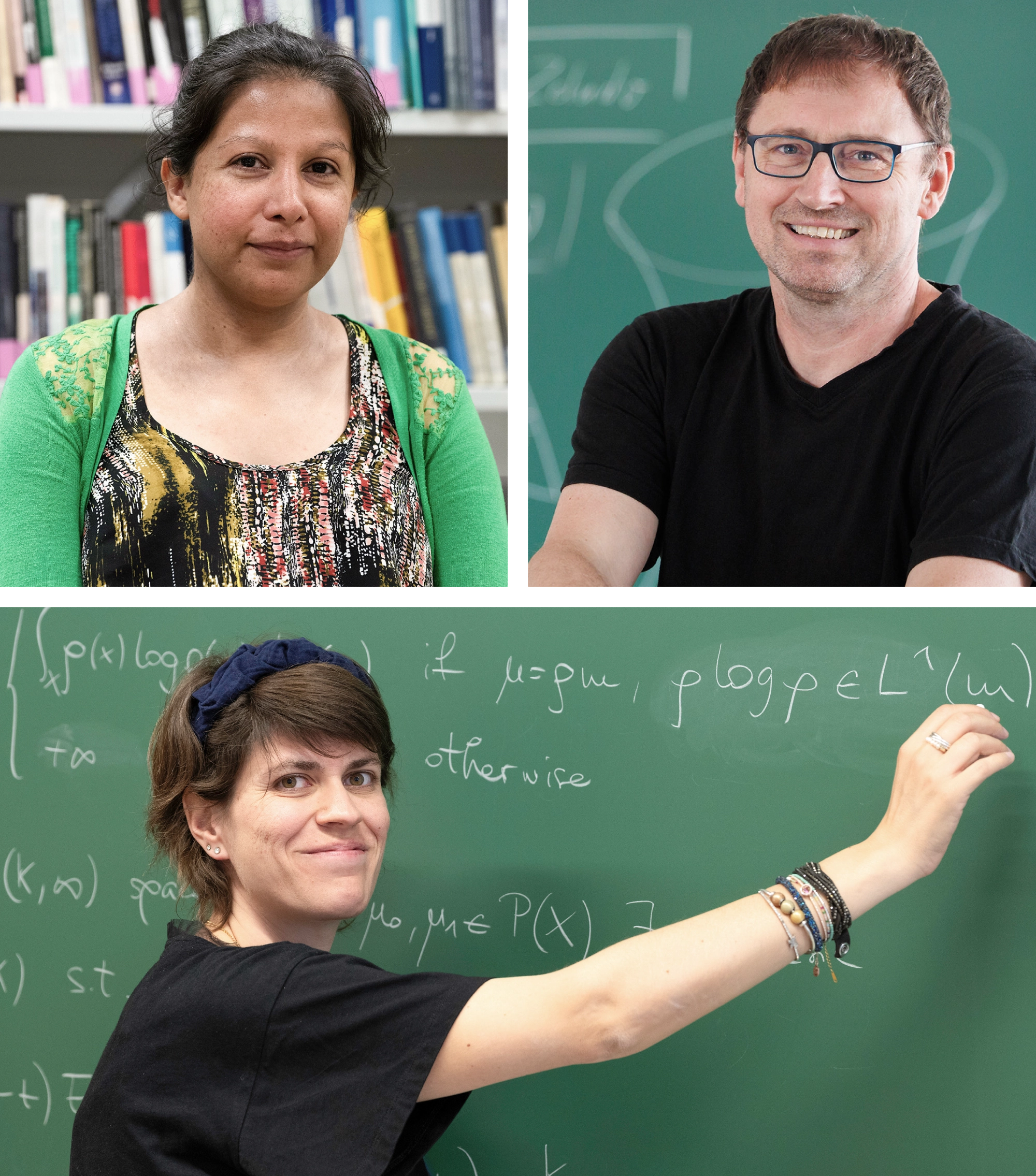
A team of mathematicians led by Roland Steinbauer (upper right) is developing new geometric techniques to answer questions about our universe. Raquel Perales (upper left) and Chiara Rigoni are two of the team’s principal investigators.
Joseph Krpelan; Martin Piskernig
Kunzinger and Sämann wanted to use their new way of estimating curvature to determine whether these singularity theorems would still be valid if they no longer assumed space-time is smooth. Would singularities persist even in rougher, more realistic-looking spaces? It’s important to find out if the smoothness condition can be waived, Sämann said, because doing so would bring the theorems closer to physical reality. After all, he added, “we believe non-smoothness is an inescapable part of the natural world.”
In 2019, together with Stephanie Alexander of the University of Illinois (who died in 2023) and Melanie Graf, now at the University of Hamburg, the mathematicians proved a special case of Hawking’s singularity theorem. For simpler models of space-time — which were not smooth, but had a special structure — they showed that if you traced the paths of particles or light rays backward in time, then those paths would have to be finite.
In other words, a singularity would inevitably arise at some point in the past.
“It’s a proof of concept that with our approach, we can prove singularity theorems that had been in more restricted, smooth domains,” Sämann said. Their triangle comparison method wasn’t just for show; it could help tell them something useful about the universe, about the presence of singularities in various kinds of space-times.
But the technique could only give them estimates of sectional curvature. And sectional curvature provides more detailed information about the curvature of space-time than Penrose’s and Hawking’s theorems had needed. By basing their argument on sectional curvature, Kunzinger, Sämann and their colleagues proved their result under a more limited set of conditions than they would have preferred to. To re-prove the singularity theorem in its full generality — as Hawking and Penrose had done — the mathematicians would instead need to base their arguments on less detailed information about curvature. They’d need to use Ricci curvature, not sectional curvature.
To achieve that, they needed some new players to join the effort.
A Napoleonic Notion
In 2018, while Kunzinger and Sämann were developing their techniques for sectional curvature, Robert McCann of the University of Toronto decided to approach the problem using tools from an entirely different area of math. In particular, he hoped to make use of a method called optimal transport.
The idea dates back to the late 18th century, when Napoleon tasked the French geometer Gaspard Monge with transporting large quantities of soil to construct fortifications. Monge used his mathematical skills to figure out the most cost-efficient way to divvy the materials up and send them to their destinations.
More than two centuries later, McCann found a way to use Monge’s technique to estimate Ricci curvature. Whereas sectional curvature tells you precisely how two-dimensional slices of a space bend in different directions, Ricci curvature gives a more average sense of that bending. It essentially measures how the volume of an object will change as it moves through regions of space-time with varying curvature. And optimal transport, McCann realized, could give you information about these changes in volume.
To get a sense of how this works, let’s consider a simpler example. Say you have a pile of sand at the Earth’s North Pole, and you want to transport it to the South Pole. You can use optimal transport techniques to study how grains of sand will move between the two poles, and how their volume will change along the way. As they travel over the surface of the Earth, following the most direct possible paths toward the equator, they spread out, encompassing a bigger volume, before contracting again. The way their volume changes reflects the curvature of the Earth.
McCann used the connection between optimal transport and curvature to develop a method for estimating the Ricci curvature of space-time without calculus. A few months later, two mathematicians — Andrea Mondino of the University of Oxford and Stefan Suhr of Ruhr University Bochum in Germany — independently achieved a similar result. But both approaches only worked when space-time was smooth.
Then, in 2020, Mondino and Fabio Cavalletti of the University of Milan figured out how to adapt these optimal transport techniques (using insights from Kunzinger and Sämann’s research) to work in non-smooth settings. They also showed that Hawking’s singularity theorem still held up in those settings. In fact, they were able to get it to work for more general models of space-time than Kunzinger and Sämann had. And their method for estimating Ricci curvature allowed them to prove the theorem without making the same limiting assumptions that Kunzinger and Sämann had to.
The proof not only showcases the power of their method, but also provides an even firmer mathematical basis for the idea of a Big Bang singularity.
“It shows that the singularity theorems are even more fundamental” than mathematicians and physicists had ever been able to show, according to Eric Ling of the University of Copenhagen, who was not involved in the research. Hawking’s and Penrose’s singularities don’t require a smooth space-time. Even in a rougher environment — one with corners or edges or other strange geometric features — they’ll inevitably arise.
“Major results in general relativity actually extend to a much weaker setting where a smooth underlying space-time is not necessary,” said Eric Woolgar, a mathematician at the University of Alberta. “The ideas involved are quite remarkable.”
A New Calculus
The ideas are still coming. Last year, McCann, Sämann and six colleagues started to develop ways to extend techniques from calculus to non-smooth settings. “We can’t do full-on calculus yet,” Sämann said, but “this should expand the toolbox a lot.” Mathematicians are already using those techniques to prove other singularity theorems and related statements.
And last month, Cavalletti and Mondino, along with Davide Manini of the Technion in Israel, became the first mathematicians to re-prove Penrose’s singularity theorem about black holes in non-smooth space-times.
Financial support has come too. Last year, Steinbauer, Kunzinger, Sämann and their colleagues received a grant of 7 million euros from the Austrian Science Fund to continue their work. They’ve been recruiting more researchers to the team, who are now working on several projects — all aimed at developing novel mathematics to expand the reach of general relativity.
Steinbauer is excited by the possibility that this program might one day help establish a mathematical foundation for a theory of quantum gravity: a long-sought way to unify the laws of general relativity with those of the submicroscopic world of quantum physics. “There are many approaches to quantum gravity which predict that, on a fundamental level, space-time is discrete,” he said. “You have isolated points in space rather than a space-time continuum. And our framework can still speak about curvature in these discrete situations.” And if it can speak about curvature, then perhaps it can speak about gravity.
Sämann can’t wait to see what this collective enterprise will turn up next. “People are still arriving,” he said. “This project is really just starting.”
Correction: July 16, 2025
An earlier version of this article misstated when Napoleon tasked Gaspard Monge with finding an efficient way to transport materials for fortifications. He did so in the 1790s, not 1781.
Correction: July 22, 2025
This article has been updated to reflect that Davide Manini’s current affiliation is the Technion in Israel, not the International School for Advanced Studies in Italy.
Clarification: July 25, 2025
This article has been updated to clarify the various contributions made by Cavalletti, Mondino and Suhr.

